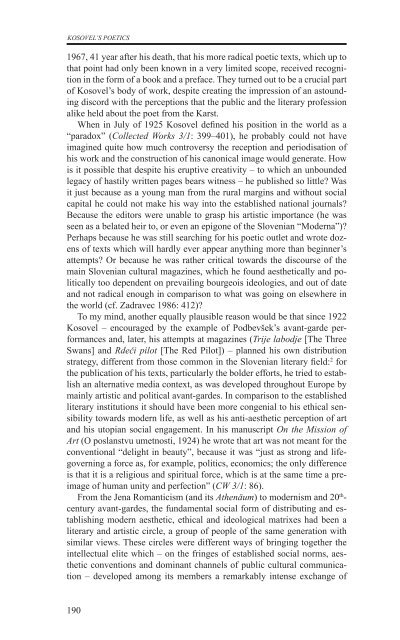razprave (pdf) - Društvo za primerjalno književnost - ZRC SAZU
razprave (pdf) - Društvo za primerjalno književnost - ZRC SAZU
razprave (pdf) - Društvo za primerjalno književnost - ZRC SAZU
- No tags were found...
You also want an ePaper? Increase the reach of your titles
YUMPU automatically turns print PDFs into web optimized ePapers that Google loves.
KOSOVEL’s poetics1967, 41 year after his death, that his more radical poetic texts, which up tothat point had only been known in a very limited scope, received recognitionin the form of a book and a preface. They turned out to be a crucial partof Kosovel’s body of work, despite creating the impression of an astoundingdiscord with the perceptions that the public and the literary professionalike held about the poet from the Karst.When in July of 1925 Kosovel defined his position in the world as a“paradox” (Collected Works 3/1: 399–401), he probably could not haveimagined quite how much controversy the reception and periodisation ofhis work and the construction of his canonical image would generate. Howis it possible that despite his eruptive creativity – to which an unboundedlegacy of hastily written pages bears witness – he published so little? Wasit just because as a young man from the rural margins and without socialcapital he could not make his way into the established national journals?Because the editors were unable to grasp his artistic importance (he wasseen as a belated heir to, or even an epigone of the Slovenian “Moderna”)?Perhaps because he was still searching for his poetic outlet and wrote dozensof texts which will hardly ever appear anything more than beginner’sattempts? Or because he was rather critical towards the discourse of themain Slovenian cultural magazines, which he found aesthetically and politicallytoo dependent on prevailing bourgeois ideologies, and out of dateand not radical enough in comparison to what was going on elsewhere inthe world (cf. Zadravec 1986: 412)?To my mind, another equally plausible reason would be that since 1922Kosovel – encouraged by the example of Podbevšek’s avant-garde performancesand, later, his attempts at magazines (Trije labodje [The ThreeSwans] and Rdeči pilot [The Red Pilot]) – planned his own distributionstrategy, different from those common in the Slovenian literary field: 2 forthe publication of his texts, particularly the bolder efforts, he tried to establishan alternative media context, as was developed throughout Europe bymainly artistic and political avant-gardes. In comparison to the establishedliterary institutions it should have been more congenial to his ethical sensibilitytowards modern life, as well as his anti-aesthetic perception of artand his utopian social engagement. In his manuscript On the Mission ofArt (O poslanstvu umetnosti, 1924) he wrote that art was not meant for theconventional “delight in beauty”, because it was “just as strong and lifegoverninga force as, for example, politics, economics; the only differenceis that it is a religious and spiritual force, which is at the same time a preimageof human unity and perfection” (CW 3/1: 86).From the Jena Romanticism (and its Athenäum) to modernism and 20 th -century avant-gardes, the fundamental social form of distributing and establishingmodern aesthetic, ethical and ideological matrixes had been aliterary and artistic circle, a group of people of the same generation withsimilar views. These circles were different ways of bringing together theintellectual elite which – on the fringes of established social norms, aestheticconventions and dominant channels of public cultural communication– developed among its members a remarkably intense exchange of190
















